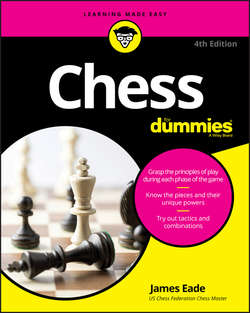Читать книгу Chess For Dummies - Eade James - Страница 9
На сайте Литреса книга снята с продажи.
Part 1
Laying the Groundwork for Champion Chess
Chapter 2
Getting to Know the Pieces and Their Powers
Acting Like a Chariot: The Rook
ОглавлениеSure, you may believe the rook is a tower or castle, but au contraire! In the history of chess, the rook actually developed from the chariot: This piece is both fast and strong, and therefore of considerable value. The rook appears a bit squatter than the other pieces, which partly accounts for the perception of it as a heavy piece (see the sidebar “Weighing in on chess heavies,” later in this chapter).
This heavy aspect can be taken too far, of course. The rook is far from a plodding piece, and the player who gets his rooks into the game most effectively often turns out to be the winner. Unfortunately, this piece begins the game tucked into a corner and usually has to wait for the other pieces to settle into their preferred squares before receiving any attention.
Figure 2-1 shows where the rooks go on the chessboard.
© John Wiley & Sons, Inc.
FIGURE 2-1: At the start of a game, the rooks hold down the corners.
The rook has the freedom to move any number of squares, but only in straight lines up and down or side to side, as indicated by the rook on d5 in Figure 2-2a. Again, think of the chariot. After a chariot gets ahead of steam, turning corners isn’t easy. Have you ever seen Ben-Hur? The rook moves just like the chariot in that movie, but without the spikes.
© John Wiley & Sons, Inc.
FIGURE 2-2: A rook can move any number of squares unless a fellow soldier is blocking it.
In Figure 2-2b, you can see that the rook can’t move to a square occupied by one of its own pieces, in this case another rook on f5 – nor can it jump over the piece and move to any of the other squares along that rank.
In Figure 2-3a, a white rook and a black rook are ready for battle. The white rook can’t move beyond the black rook along that rank, but it can capture it by removing the black piece and taking its place, as in Figure 2-3b. (In chess notation, this move is written 1. Rxf5 – see Chapter 6 for details on notation.) This concept is the same for the other chessmen (and woman) with the exception of the king, which is immune to capture. But don’t think that you have to capture when given the opportunity. This isn’t checkers!
© John Wiley & Sons, Inc.
FIGURE 2-3: The white rook attacks and captures the black rook.
When new players discover the power of the rook, they sometimes decide to move the pawns that are in front of the rooks forward at the beginning of the game (these pawns are known as the rook pawns). This action has the advantage of increasing the space available to the rook but is usually a poor way to open the game. The rook must retreat when attacked by an enemy pawn, knight, or bishop because it’s too valuable to be lost in exchange for one of them. Time is then lost shuffling the rook to and fro while the enemy pieces come out in force. The best strategy, especially early in the game, is to move a minimum number of pawns, get the minor pieces (knights and bishops) out, and only then move on to the rooks.
WEIGHING IN ON CHESS HEAVIES
The rook and the queen are sometimes referred to as heavy or major pieces, because the rook and the queen, assisted by their own king, can checkmate an enemy king by themselves (see Chapter 4 for a discussion of checkmate). Minor pieces – a knight or a bishop – can’t checkmate an enemy king with only their own king for assistance.
